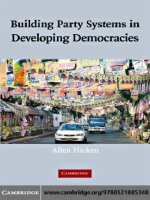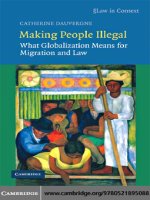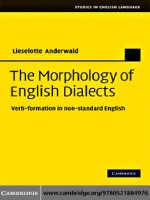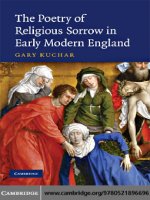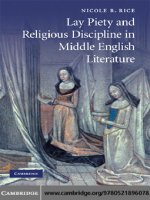cambridge university press the morphology of english dialects verb formation in non standard english apr 2009 kho tài liệu bách khoa
Bạn đang xem bản rút gọn của tài liệu. Xem và tải ngay bản đầy đủ của tài liệu tại đây (2.97 MB, 241 trang )
This page intentionally left blank
The Morphology of English Dialects
Where do dialects differ from Standard English, and why are they so
remarkably resilient? This new study argues that commonly used verbs
that deviate from Standard English for the most part have a long pedigree. Analysing the language use of over 120 dialect speakers, Lieselotte
Anderwald demonstrates that not only are speakers justified historically in
using these verbs, systematically these non-standard forms actually make
more sense. By constituting a simpler system, they are generally more economical than their Standard English counterparts. Drawing on data collected from the Freiburg English Dialect Corpus (FRED), this innovative
and engaging study comes directly from the forefront of this field, and will
be of great interest to students and researchers of English language and
linguistics, morphology and syntax.
L I E S E L O T T E A N D E RWA L D
University of Kiel, Germany.
is Professor of English Linguistics at the
studies in english language
General Editor
Merja Kytö (Uppsala University)
Editorial Board
Bas Aarts (University College London), John Algeo (University of Georgia), Susan Fitzmaurice
(Northern Arizona University), Charles F. Meyer (University of Massachusetts)
The aim of this series is to provide a framework for original studies of English, both present-day and
past. All books are based securely on empirical research, and represent theoretical and descriptive
contributions to our knowledge of national and international varieties of English, both written and
spoken. The series covers a broad range of topics and approaches, including syntax, phonology, grammar,
vocabulary, discourse, pragmatics and sociolinguistics, and is aimed at an international readership.
Already published in this series:
Christian Mair
Infi nitival Complement Clauses in English: A Study of Syntax in Discourse
Charles F. Meyer
Apposition on Contemporary English
Jan Firbas
Functional Sentence Perspective in Written and Spoken Communication
Izchak M. Schlesinger
Cognitive Space and Linguistic Case
Katie Wales
Personal Pronouns in Present-Day English
Laura Wright
The Development of Standard English, 1300–1800: Theories, Descriptions, Confl icts
Charles F. Meyer
English Corpus Linguistics: Theory and Practice
Stephen J. Nagle and Sara L. Sanders (eds.)
English in the Southern United States
Anne Curzan
Gender Shifts in the History of English
Kingsley Bolton
Chinese Englishes
Irma Taavitsainen and Päivi Pahta (eds.)
Medical and Scientific Writing in Late Medieval English
Elizabeth Gordon, Lyle Campbell, Jennifer Hay, Margaret Maclagan, Andrea Sudbury, and Peter Trudgill
New Zealand English: Its Origins and Evolution
Raymond Hickey (ed.)
Legacies of Colonial English
Merja Kytö, Mats Rydén, and Erik Smitterberg (eds.)
Nineteenth Century English: Stability and Change
John Algeo
British or American English? A Handbook of Word and Grammar Patterns
Christian Mair
Twentieth-Century English: History, Variation and Standardization
Evelien Keizer
The English Noun Phrase: The Nature of Linguistic Categorization
Raymond Hickey
Irish English: History and Present-Day Forms
Günter Rohdenburg and Julia Schlüter (eds.)
One Language, Two Grammars?: Differences between British and American English
Laurel J. Brinton
The Comment Clause in English
The Morphology of
English Dialects
Verb Formation in Non-Standard
English
LI ESELOT TE A N DERWA LD
CAMBRIDGE UNIVERSITY PRESS
Cambridge, New York, Melbourne, Madrid, Cape Town, Singapore, São Paulo
Cambridge University Press
The Edinburgh Building, Cambridge CB2 8RU, UK
Published in the United States of America by Cambridge University Press, New York
www.cambridge.org
Information on this title: www.cambridge.org/9780521884976
© Lieselotte Anderwald 2009
This publication is in copyright. Subject to statutory exception and to the
provision of relevant collective licensing agreements, no reproduction of any part
may take place without the written permission of Cambridge University Press.
First published in print format 2009
ISBN-13
978-0-511-51793-8
eBook (NetLibrary)
ISBN-13
978-0-521-88497-6
hardback
Cambridge University Press has no responsibility for the persistence or accuracy
of urls for external or third-party internet websites referred to in this publication,
and does not guarantee that any content on such websites is, or will remain,
accurate or appropriate.
To Lucian, Eva, Julia, and Emma
Contents
List of figures
List of maps
List of tables
Preface and thanks
Acknowledgement of sources
page xii
xiv
xv
xvii
xviii
1
Introduction
1.1 The past tense – a descriptive approach
1.2 Terminology: strong–weak vs. irregular–regular
1.3 Classification of strong verbs
1.3.1 Ablaut series, vowel gradation
1.3.2 Dental suffix
1.3.3 Abstract formal identity
1.4 Standard vs. non-standard English
1.5 Materials employed
1
1
3
5
5
6
7
12
13
2
Past tense theories
2.1 Introduction
2.2 Chomsky and Halle (1968)
2.3 Lexical Phonology and Morphology
2.4 Optimality Theory
2.5 Stochastic Optimality Theory
2.6 Psycholinguistic theories
2.7 Connectionist approaches
2.8 Network model
2.9 Natural morphology
2.9.1 Universal morphological naturalness
2.9.2 Language-specific morphological naturalness
2.9.3 Criticism
2.9.4 Compatibility with other models
2.10 Conclusion
17
17
18
21
26
32
33
36
38
40
40
42
45
45
46
vii
viii
Contents
3
Naturalness and the English past tense system
3.1 General features of the English verb system
3.2 Dominant features
3.3 Standard English verb classes
3.3.1 Verb class 1: PRES ≠ PAST ≠ PPL
3.3.1.1 VPRES ≠ VPAST ≠ VPPL
3.3.1.2 <-en>-participle
3.3.2 Verb class 2: PRES ≠ PAST = PPL
3.3.2.1 VPRES ≠ VPAST = VPPL
3.3.2.2 No vowel change
3.3.3 Verb class 3: PRES = PPL ≠ PAST
3.3.4 Verb class 4: PRES = PAST ≠ PPL
3.3.5 Verb class 5: PRES = PAST = PPL
3.3.6 Summary
3.4 The central characteristics
3.5 Non-standard verb paradigms as test cases
3.5.1 New non-standard weak verbs
3.5.2 New non-standard strong verbs
3.5.3 Different non-standard strong verbs
3.5.3.1 Two- instead of three-part paradigms
3.5.3.2 One- instead of two-part paradigms
3.5.4 Summary
49
49
51
51
52
53
53
55
55
57
58
58
59
59
61
61
62
62
63
63
65
65
4
Sellt and knowed: non-standard weak verbs
4.1 Introduction
4.2 Data from FRED: what to count?
4.3 Regional comparison
4.4 Individual verbs
4.4.1 Northern features
4.4.1.1 Past tense gaed and gi’ed
4.4.1.2 Past tense tellt and sellt
4.4.2 Southern features
4.4.2.1 Past tense runned
4.4.2.2 Past tense gived
4.4.2.3 Past tense knowed, growed, blowed and throwed
4.4.2.4 Historical dialect data
4.4.2.5 Past tense drawed
4.4.2.6 Relative frequencies
4.4.3 Western feature
4.4.3.1 Past tense seed
4.4.4 General features
4.4.4.1 Past tense knowed
4.4.4.2 Past tense catched
4.5 Verb classes
66
66
68
69
70
73
73
73
77
77
78
79
81
82
83
84
84
87
87
89
91
Contents
4.6 Statistical models
4.7 Comparison with COLT
4.8 Summary
5
Drunk, seen, done and eat: two-part paradigms instead of
three-part paradigms
5.1 Introduction
5.2 ‘Bybee’ verbs
5.2.1 History
5.2.1.1 Past tense forms of begin
5.2.1.2 Past tense forms of drink
5.2.1.3 Past tense forms of sink
5.2.1.4 Past tense forms of sing
5.2.1.5 Past tense forms of ring
5.2.2 Historical dialects
5.2.3 Data from FRED
5.2.3.1 Verbs
5.2.3.2 Singular vs. plural?
5.2.3.3 Regions
5.2.4 Comparison with COLT
5.2.5 Cognitive explanation
5.3 Past tense seen
5.3.1 Introduction
5.3.2 History
5.3.3 Historical dialects
5.3.4 Data from FRED
5.3.5 Conclusion
5.4 Past tense done
5.4.1 Introduction
5.4.2 History
5.4.3 Previous studies
5.4.4 Historical dialects
5.4.5 Data from FRED
5.4.6 Data from COLT
5.4.7 Done in American English
5.4.8 Cognitive explanation
5.5 Counterexamples: past tense eat, give and see
5.5.1 Introduction
5.5.2 Past tense eat
5.5.2.1 History
5.5.2.2 Historical dialects
5.5.2.3 Data from FRED
5.5.2.4 Conclusion past tense eat
ix
92
95
96
98
98
98
101
103
105
106
107
108
109
110
110
110
111
113
114
120
120
120
121
121
125
125
125
126
127
127
129
132
133
134
136
136
136
137
137
138
140
x
Contents
5.5.3 Past tense give
5.5.3.1 History
5.5.3.2 Historical dialects
5.5.3.3 Data from FRED
5.5.4 Past tense see
5.5.4.1 Historical dialects
5.5.4.2 Data from FRED
5.5.4.3 Data from COLT
5.5.5 Conclusions
5.6 Chapter conclusion
141
141
141
142
144
144
144
145
146
147
6
Come and run: non-standard strong verbs with a
one-part paradigm
6.1 Past tense come
6.1.1 Introduction
6.1.2 History
6.1.2.1 Regular development
6.1.2.2 Standard English past tense came
6.1.3 Historical dialects
6.1.4 Data from FRED
6.1.5 Data from COLT
6.1.6 Summary and explanation
6.2 Past tense run
6.2.1 Introduction
6.2.2 History
6.2.2.1 Present tense
6.2.2.2 Past tense
6.2.3 Historical dialects
6.2.4 Data from FRED
6.2.4.1 Procedure
6.2.4.2 Quantification
6.2.5 Data from COLT
6.2.6 Cognitive explanation
6.3 Chapter conclusion
149
149
149
150
150
153
158
163
165
166
168
168
168
168
174
176
176
176
178
179
179
180
7
Conclusion: supralocalization and morphological theories
7.1 Summary of findings
7.2 Supralocalization?
7.3 Morphological theories revisited
7.3.1 Rules vs. representations
7.3.2 The role of frequency
7.3.3 Accounting for diachronic developments
7.3.4 Non-standard data
7.4 Summary
183
183
185
188
188
191
191
194
197
Contents
Appendix 1: Verb classification
Appendix 2: SED localities and list of counties
Bibliography
Index
xi
198
205
207
216
List of figures
Figure 1.1
Figure 1.2
Figure 2.1
Figure 2.2
Figure 2.3
Figure 3.1
Figure 3.2
Figure 3.3
Figure 3.4
Figure 3.5
Figure 4.1
Figure 4.2
Figure 4.3
Figure 4.4
Figure 4.5
Formal identity of forms
Verb patterns, ordered by functionality
Dual-route models
Product-oriented schema for past tense forms
Inflection class classification (after Wurzel 1990)
Internal structure of verb class 1
Internal structure of verb class 2
Summary of verb class structures
Features and class membership
Pervasive patterns in non-standard tense paradigms
Non-standard weak verbs per dialect area (normalized)
A-curve for non-standard weak verbs
A-curve for non-standard weak verbs excluding knowed
Verb class 1 affected by non-standard weak forms
Relative vs. absolute frequencies for non-standard weak
verbs in FRED
Figure 4.6 Scatterplot of relative vs. absolute frequencies of
non-standard weak verbs
Figure 4.7 Curve estimation on relative vs. absolute frequencies of
non-standard weak verbs
Figure 5.1 Past tense, Bybee verbs
Figure 5.2 Diachronic development of past tense begun
(Helsinki, ARCHER)
Figure 5.3 The demise of past tense sunk (ARCHER)
Figure 5.4 Diachronic development of past tense rung vs. rang
(Helsinki, ARCHER)
Figure 5.5 The five most frequent Bybee verbs per dialect area
in FRED
Figure 5.6 Schema for past tense begun
Figure 5.7 Schema for past tense rung
Figure 5.8 Schema for past tense sung
Figure 5.9 Schema for past tense sunk
Figure 5.10 Schema for past tense drunk
xii
8
11
34
39
46
54
59
60
62
64
70
72
72
92
93
94
95
100
104
107
109
112
116
116
116
117
117
List of figures
Figure 5.11
Figure 5.12
Figure 5.13
Figure 5.14
Figure 5.15
Figure 5.16
Figure 5.17
Figure 5.18
Figure 5.19
Figure 5.20
Figure 6.1
Figure 6.2
Figure 6.3
Figure 6.4
Figure 6.5
Figure 6.6
Figure 6.7
Figure 6.8
Figure 6.9
Figure 6.10
Figure 6.11
Figure 6.12
Figure 6.13
Figure 7.1
Figure 7.2
Stable word class as attractor
Prototypical structure of verb class (Bybee verbs)
Past tense seen, seed and see per dialect area in FRED
Past tense done (main verb) per dialect area in FRED
Schema for past tense done
Prototypicality grid of Bybee verbs including done
Past tense eat per dialect area in FRED
Past tense give per dialect area in FRED
Standard English three-part paradigm
Non-standard English two-part paradigms
Postulated regular development of present and
past tense come
Marked regular development of past tense coom
Phonological development of come
The rise of past tense came (Helsinki corpus,
normalized figures)
Past tense come per dialect area in FRED
Paradigm of non-standard come
Schema for past tense come
Come as a Bybee verb
Present tense run (Helsinki corpus)
Past tense run per dialect area in FRED
Schema for past tense run
Run as a Bybee verb
Prototypicality grid of Bybee verbs including come
and run
New Bybee verbs
Extension of network model to variable data
xiii
117
119
124
132
135
135
140
143
148
148
151
153
153
158
164
166
167
167
173
178
180
180
181
190
196
List of maps
Map 1.1
Map 4.1
Map 4.2
Map 4.3
Map 4.4
Map 5.1
Map 5.2
Map 5.3
Map 5.4
Map 5.5
Map 5.6
Map 5.7
Map 5.8
Map 6.1
Map 6.2
Map 6.3
Map 6.4
Map 6.5
Map 6.6
Map 6.7
Map 6.8
Map 6.9
Map 6.10
xiv
English counties sampled in FRED
Past tense sellt and tellt in the EDD
Past tense growed in the SED (Basic Material)
Past tense seed, seen and see in the SED (Basic Material)
Past tense catched in the SED (Basic Material)
Past tense seen in the EDD
Past tense seed, seen and see in the SED (Basic Material)
Past tense done in the EDD
Past tense done in the SED (by counties)
Past tense done in the SED (Basic Material)
Past tense eat in the SED (Basic Material)
Past tense give in the EDD
Past tense see in the SED (Basic Material)
Past tense came in LALME
Past tense come in LALME
Past tense comed in the EDD
Past tense coom in the EDD
Past tense come in the EDD
Past tense coom in the SED (Basic Material)
Present tense run metathesis in LALME
Present tense rin in LALME
Past tense run in LALME
Past tense run in the EDD
15
75
82
86
90
122
123
128
130
131
139
142
145
155
156
159
160
161
163
170
171
175
177
List of tables
Table 1.1
Table 2.1
Table 2.2
Table 2.3
Table 2.4
Table 4.1
Table 4.2
Table 4.3
Table 4.4
Table 4.5
Table 4.6
Table 4.7
Table 4.8
Table 4.9
Table 4.10
Table 4.11
Table 4.12
Table 4.13
Table 5.1
Table 5.2
Table 5.3
Table 5.4
Table 5.5
Table 5.6
Table 5.7
Table 5.8
Table 5.9
Table 5.10
FRED words per dialect area
Example 1 OT tableau
Example 2 OT tableau
Example 3 OT tableau
Schematic comparison of morphological theories
Non-standard weak verbs per dialect area (normalized)
Individual weak verbs per dialect area
Relative frequencies of tellt in FRED
Relative frequencies of sellt in FRED
Relative frequencies of drawed in FRED
Relative frequencies of blowed in FRED
Relative frequencies of throwed in FRED
Relative frequencies of growed in FRED
Relative frequencies of seed in FRED
Relative frequencies of knowed in FRED
Relative and absolute frequencies of know etc. in FRED
Relative frequencies of catched in FRED
Relative and absolute frequencies of all non-standard
weak verbs in FRED
Diachronic development of past tense began vs. begun
(Helsinki, ARCHER)
Diachronic development of past tense sank vs. sunk
(ARCHER)
Diachronic development of past tense rang vs. rung
(Helsinki, ARCHER)
New ‘Bybee’ verbs in FRED
Singular referents of Bybee verbs
The five most frequent Bybee verbs per dialect area
in FRED
New Bybee verbs in COLT
Relative frequencies of seen in FRED
Past tense seen in COLT
Past tense done (main verb) in FRED
16
29
29
29
47
70
71
76
77
84
84
84
84
86
88
88
91
93
104
106
108
110
111
112
114
124
125
132
xv
xvi
Table 5.11
Table 5.12
Table 5.13
Table 5.14
Table 5.15
Table 6.1
Table 6.2
Table 6.3
Table 6.4
Table 7.1
List of tables
Past tense done (main verb) in COLT
133
Past tense eat in FRED
140
Past tense give in FRED
143
Past tense see in FRED
146
Past tense see in COLT
146
Past tense (he/she/it) come in FRED
164
Past tense (he/she/it) come in COLT
165
Diachronic development of present tense run (Helsinki corpus) 173
Past tense run in FRED
178
Supralocalization features
187
Preface and thanks
While tense and aspect in general have always interested me since my days
as a student at the Free University Berlin and a class on the topic by Ekkehartd
König, my interest in the non-standard past tense arose purely coincidentally. I
was asked to write an overview of the morphology and syntax of the South East
of England (Anderwald 2004), when – in the pursuit of some little-documented
feature – I fell to reading whole texts from our corpus FRED from this area,
especially those from London, noting down rather informally all non-standard
features I came across. Many questions that this article raised could not be
answered immediately, but I thought they deserved a more thorough investigation. In particular, the many and varied non-standard past tense forms had
never been investigated in their regional extension, and I had the feeling that
this would make a satisfying research topic.
I have to thank countless colleagues, whom I pestered with sometimes incomprehensible questions about verbal paradigms, in particular Øystein Vangsnes
in Norway for answering questions on Old Norse, Nynorsk and Icelandic; Karel
Gildemacher from the Fryske Akademie in the Netherlands for information on
past and present-day Frisian; Ton Goeman for information on Dutch (standard
and dialects); my colleague Richard Matthews for discussing the history of come
with me; Christian Mair and Bernd Kortmann for discussion and suggestions
during the infamous Oberseminar, and elsewhere, and support and coaching in
the most general ways; Peter Trudgill for (very entertaining) anecdotal evidence
on East Anglian verb forms; Benedikt Szmrecsanyi and Douglas Biber for helpful suggestions on some statistical procedures and some number crunching; my
good friends Marianne and Andrea; Georgie, my favourite native speaker of no
dialect at all ☺ (thanks also for proofreading); Lucian not just for help with
soft-, hard- and other -ware problems; and, most of all, Eva and Julia and Emma
for making life fun – my family to whom this book is dedicated.
xvii
Acknowledgement of sources
Thanks to Joan Bybee for letting me name a whole verbal class after her.
Maps are based on the Survey of English Dialects overview map indicating the
location of their informants in Orton and Halliday (1962–64: 30). Counties in
these maps are numbered. For easier reference, a complete list of county names
and numbers can be found in Appendix 2. I gratefully acknowledge that Hodder
Education have no objections to my using the basic map in this book.
It has to be noted here that every effort has been made to secure necessary
permissions to reproduce copyright material in this work, though in some cases
it has proved impossible to trace copyright holders. If any omissions are brought
to our notice, we will be happy to include appropriate acknowledgements on
reprinting or in any subsequent edition.
xviii
1
Introduction
But it was in the verbal conjugation that the Ablaut found its
peculiar home, and there it took formal and methodical possession. (Earle 1892: §124)
1.1 The past tense – a descriptive approach
PAST is the most frequently marked verbal category by far (e.g. according to
Sampson 2002, based on figures from the British National Corpus), accounting for around 25 per cent of all verb forms in contemporary spoken British
English. In comparison, the two next categories, negation or modals, both
only account for roughly 12 per cent of verb forms, the perfect for around 8
per cent, and the progressive for under 6 per cent. The passive finally is at
best marginal with a text probability of under 1 per cent.
Past tense formation in English appears to be a very simple matter.
Nevertheless – or perhaps because of this simplicity – great theoretical significance has been attached to an analysis of the past tense because it is used
as the prime example in a long-standing debate in morphological theory
(more on which in Chapter 2).
Putting it in simple descriptive terms (although no description is of course
theory-free, or truly pre-theoretical), the majority of English verbs today
have past tense forms that consist of the present tense stem plus <-ed>.1
<-ed>, the weak past tense marker, is exactly parallel to the weak past tense
in all other Germanic languages and is indeed one of the characterizing features of Germanic. English here is no exception. There are several theories,
each deficient in its own terms, of how this common dental suffix evolved
with the specific past tense meaning – among them the ‘tun theory’ and
the ‘-tó- theory’2 – but a consensus cannot as yet be presented. Although
it is probably generally true that, from an Indo-European perspective, the
1
2
In contrast to most reference grammars, I disregard variation in spelling here, although I
will refer to the graphemes for simplicity’s sake.
For a short overview, see West (2001: 53).
1
2
The Morphology of English Dialects
weak verbs are the more recent innovation,3 inside the weak verb class there
appear to be different layers: some weak verbs are very old and can be traced
to Indo-European roots (and thus constitute rather untypical weak verbs),
whereas the majority are probably younger.4
Today, for the weak past tense forms, in English we have three regular
allomorphs: /əd/ or /ɪd/ after the two alveolar stops /t/ and /d/, /t/ after
all other voiceless sounds, and /d/ after all other voiced sounds. This case
of phonologically determined allomorphy is perfectly regular and equally
productive. The rarer verbs in particular, as well as neologisms and loan
words, are weak today. The number of paradigms of weak verbs is very large
(because of possible new coinages probably infinite), so that a high type frequency is here coupled with a low token frequency.
A small number of verbs in contemporary (standard) English – Quirk
et al. list ‘250 or so’ (Quirk et al. 1985: 104), Huddleston and Pullum have
exactly 176 (Huddleston and Pullum 2002: 1608–9), although other linguists
name considerably fewer – are irregular and have retained strong past tense
forms. This group has been gradually decreasing in number, as strong verbs
have changed verb classes and become weak verbs since Old English times
(see in particular Krygier 1994 for a detailed analysis through the centuries
until Early Modern English). Nevertheless, strong verb forms are still highly
visible in present-day English because the frequent verbs in particular have
retained their strong forms. Indeed, some text counts put the figure for
strong verbs in running text as high as 70 to 75 per cent.5 For strong verbs,
then, low type frequency is coupled with a very high token frequency.6
Incidentally, Quirk et al.’s classification seems to be the most inclusive.
For them, all verbs that are not regular are irregular. While regular verbs
can be defined positively, irregular verbs simply constitute ‘the rest’ (a rather
heterogeneous category that will be discussed further below). Perhaps for
this reason, the terms strong verb and weak verb do not appear in Quirk et al.
(1985). Other authors, especially those arguing from a historical point of
view, are more discriminatory. Stockwell and Minkova, for example, quoting
3
4
5
6
As opposed to the strong verbs, which can be shown to re-use the old aorist; for a recent
treatment in terms of exaptation, see Lass (1990).
The Newcastle Weak Verb Project aims to shed light on this layering (see West 2001). First
studies for Old High German suggest that about 70 per cent of weak verbs are neologisms,
18 per cent are West Germanic, 10 per cent are Germanic and around 2 per cent could be
pre-Germanic (West 2001: 54). Figures for Old English were not available at the time of
writing.
E.g. in transcripts of parental speech, see Pinker (1999: 227). Based on Sampson’s
CHRISTINE corpus, a subcorpus of the British National Corpus (BNC), Dahl (2004:
300–1) quotes even more striking figures. Of all verb forms, regular verbs only make up
around 9 per cent of all tokens. If one disregards be, have as well as modals, regular verbs
still make up only around 24 per cent of all lexical verb tokens, figures very similar to
Pinker’s.
This is an oversimplification. In fact, some of the very frequent verbs are weak (look, ask,
seem, want, turn …), while many strong verbs have a very low token frequency. As a statistical trend, however, this statement holds.
Introduction
3
Baugh and Cable (1978), only mention sixty-eight strong verbs (Stockwell
and Minkova 2001: 130), i.e. those that form the past tense by vowel gradation, going back to similar processes in Indo-European, plus thirteen that
are both strong and weak today; Carstairs-McCarthy occupies some middle ground in claiming that ‘in all, 150 or so verbs are irregular in that they
do not use the -ed suffix’ (Carstairs-McCarthy 2002: 40), without, however,
supplying a list.
As Quirk et al. do provide a comprehensive list of all strong verbs and
their various forms, this will constitute the point of departure for my study,
the foil against which any non-standard forms will be compared. However,
from their list of 250 verbs I excluded 83 which were either morphologically
complex (e.g. deepfreeze; the simplex freeze is included) or behaved as if
they were (e.g. become, cf. come).7 These were mostly verbs with the prefixes a-, be-, for(e)-, mis-, out-, over-, re-, un-, under-, up- and with-. Clearly
in most cases the prefixes are not semantically transparent today, and many
verbs are thus arguably monomorphemic. For our purposes it is important
to note, however, that they behave morphologically as if they were derivational forms. To avoid skewing due to frequent prefixation of some bases in
the later quantitative comparisons, these seemingly derivational forms were
excluded. Incidentally, these exclusions bring Quirk et al.’s list very close to
the figure ‘150 or so’ mentioned by Carstairs-McCarthy above, namely to a
total of 167.8 Quirk et al.’s complete list of strong verbs with all exclusions
can be found in Appendix 1.
1.2
Terminology: strong–weak vs. irregular–regular
A brief note on terminology: in this book, I will use the terms strong and
weak verbs for the verbs that in more modern terminology (see Quirk et al.
1985; Huddleston and Pullum 2002) are usually called irregular and regular.
In particular, strong verb will be used as a cover term not only for verbs that
display the characteristic Indo-European vowel gradation, but for any other
irregular verb as well. The reason for this choice is twofold. Firstly, we will
have to have recourse to the concept of regularization, an abstract cognitive
7
8
Huddleston and Pullum also stress that ‘verbs with complex bases’ have ‘irregular forms
matching those of the simple verb in final position’ (2002: 1609), pointing out that ‘the
inflectional-morphological relationship is thus maintained long after the semantic connection has been lost’ (2002: 1610). Aronoff goes further and in fact takes ‘the inheritance of
irregular morphology from a root or morphological head, even in the absence of compositionality’ as proof for a level of analysis ‘between morphosyntax and morphophonology’, i.e.
as morphology in the narrow sense, claiming that ‘in each case, the set of irregular forms is
obviously not a single lexeme … so their unity must be expressed at a purely morphological
level’ (Aronoff 1994: 28).
Huddleston and Pullum’s list is slightly longer with a total of 176 verbs (2002: 1608–9); in
contrast to Quirk et al., they include bid twice, and add bust, earn, fit, gird, sneak and thrive,
as well as the four modals can, may, shall and will. On the other hand, their list does not
include knit, shit or sweat.
4
The Morphology of English Dialects
process that can apply at a number of different linguistic levels. As regularization is not necessarily confined to the process of turning irregular verbs
into regular verbs, to avoid utter confusion the terms irregular and regular
verbs will not be used in this book after this introduction. If the following
sections and chapters mention strong verbs, then, it should be borne in mind
that this does not only include strong verbs in the narrower sense, i.e. those
verb paradigms displaying Indo-European vowel gradation, but also verbs
that Stockwell and Minkova call strong and weak, i.e. any verbs that are not
weak verbs.9
Secondly, the term regular (at least in some frameworks) might presuppose, based on perhaps overzealous etymologizing, that a rule (Latin regula)
is involved in the production of this form. This is a presupposition that I will
be trying to avoid. In particular, in Chapter 5 and throughout the book I will
be arguing that there can be both weak (‘regular’) verbs that are not created
through a rule, and, more importantly, strong verbs (‘irregular’ verbs) that
nevertheless follow a rule, or pattern, in their formation.
Finally, the data employed here are mainly historical as well as dialectal.
While in historical studies it is of course still the case that the terms strong
and weak verbs are used, the situation in dialectology is a little different.
Again, works with a strong historical focus tend to avoid the terms regular
and irregular and use strong and weak instead (despite the title, for example, Cheshire uses ‘strong’ and ‘weak’ in her analysis of the English irregular verbs: see Cheshire 1994; see also Miller 2003: 74). When I chart the
progress of individual verb forms through history to their dialectal status
today, it will be particularly useful to be able to use the same terms, rather
than switch from strong – weak to regular – irregular at some arbitrary point
in time (e.g. the change from Middle English to Modern English; the change
from historical linguistics to synchronic linguistics; the change from dialectology to sociolinguistics; and what would be the respective dates for these
important changes?).
Nevertheless, I am aware of several complications in this choice of terminology. Words that were weak in Old English (like teach) would have to be
treated as having ‘jumped’ to the strong verb class, whereas what ‘really’
happened was of course a series of sound changes that resulted in opacity and, indeed, irregularity for this form.10 Clearly taught is not perceived
9
Cf. McMahon’s terminology, which is similar: ‘The Modern English strong verbs … will
be defined for present purposes as all those verbs which do not simply add a dental suffix
{D} … to mark the past tense, but also, or instead, change the quality of the stem vowel …
The term “strong” therefore designates not only historically strong verbs, but also historically weak verbs which now exhibit a vowel mutation in the past tense’ (McMahon 2000:
129). In her analysis, it is not clear whether she really wants to exclude paradigms like hit –
hit – hit.
10
The Germanic spirant law (or Primärberührung) resulted in the spirantization of /k/ >
/x/ before the alveolar in the past tense, but not the present, whereas the vowel change is
due to ‘reverse vowel gradation’ (usually known by its German name of Rückumlaut).
Introduction
5
today any longer as containing the regular weak ending <-ed>, and so it
would be misleading (for a synchronic analysis) to classify teach as a ‘weak’
verb today.11 On the other hand, a modern interpretation of ‘strong verb’ as
identical to ‘irregular’ verb stresses for example the vowel change that takes
place between teach and taught. Although of course it does not go back to an
Indo-European ablaut schema, and indeed should not be called ablaut, vowel
change between present and past tense stems is still one of the most frequent
characteristics in the group of strong verbs (although not all of them, as we
shall see in section 3.3).
1.3 Classification of strong verbs
1.3.1
Ablaut series, vowel gradation
Among the strong verbs, several classifications have been proposed.
Classically, divisions are historical in nature, but among Germanic scholars
it seems widely accepted that ‘the English strong verbs are probably the most
difficult of any modern West Germanic language to classify in any systematic
way’ (Durrell 2001: 13), no doubt because English has moved furthest away
from its typological relatives German or Dutch in many respects. Typically,
for example, verbs are grouped together by the same vowel changes they
contain, according to present-day English, Old English, West Germanic, or
indeed Indo-European ablaut series (e.g. /ɪ/~/æ/~/K/ sing – sang – sung;
begin – began – begun vs. /е/~/ɔ/ bear – bore – borne; tear – tore – torn, etc.).
For present-day English, but clearly based on Old English schemas, this
classification typically yields seven verb classes (e.g. Katamba 1993: 102):
Class I:
Class II:
Class III:
Class IV:
Class V:
Class VI:
Class VII:
/аɪ/ /ǝʊ/ /ɪ/
/i:/ /ǝʊ/ /ǝʊ/
/ɪ/ /æ/ /ʌ/
/еǝ/ /ɔǝ/ /ɔ:/
/ɪ/ /еɪ/ /ɪ/
/ǝʊ/ /u:/ /ǝʊ/
/æ/ /ʊ/ /ʊ/
rise
freeze
shrink
bear
give
know
stand
rose
froze
shrank
bore
gave
knew
stood
risen
frozen
shrunk
borne
given
known
stood
The problem with this classification according to ablaut series is that it
accounts for only a minority of strong verbs today, even though it is specifically written for present-day English, not historical stages of the language.
Katamba’s classification, for example, can only include 49 strong verbs – that
is less than 30 per cent of the 167 strong verbs today. It neglects many vowel
series of verbs that were strong in Old English and have remained so until
11
Some synchronic descriptions resort to classifying these verbs as ‘partial suppletion’; see
Aronoff and Fudeman (2005: 168–9), as almost the complete stem /tiːtʃ/ is ‘replaced’ in
/tɔːt/ (with the exception of the initial consonant).
